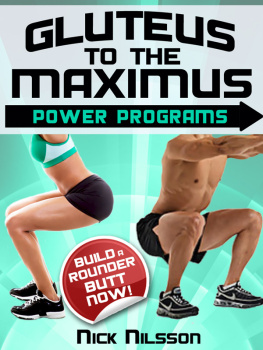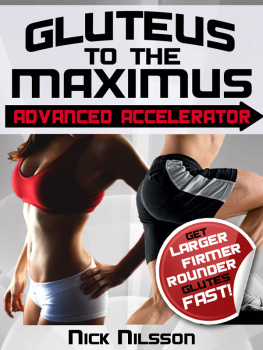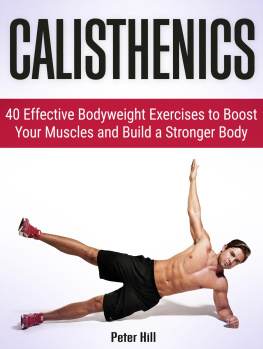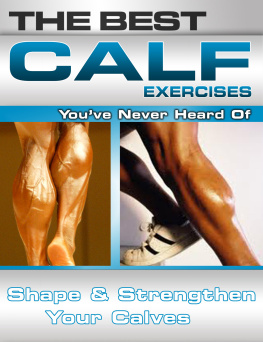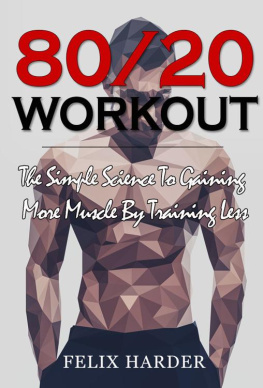The Best Trapezius Exercises Youve Never Heard Of
Build and Strengthen Your Traps
By Nick Nilsson

Prior to beginning any exercise program, you must consult with your physician. You must also consult your physician before increasing the intensity of your training. The information in this book is intended for healthy individuals. Any application of the recommended material in this book is at the sole risk of the reader, and at the readers discretion. Responsibility of any injuries or other adverse effects resulting from the application of any of the information provided within this book is expressly disclaimed.
Price World Publishing
www.PriceWorldPublishing.com
Copyright 2011 by Nick Nilsson
All rights reserved. Neither this book, nor any parts within it may be sold or reproduced in any form without permission.
eISBN: 9781936910090
Table of Contents
Introduction:
In this book you will find fantastic trapezius exercises.
How To Do It:
Read through the exercise descriptions thoroughly so you know exactly what the exercise is going to accomplish, how to execute it properly and safely and how to best incorporate the exercise into your workouts.
Common Errors:
The Common Errors section of each exercise will let you know some of the typical ways the exercise is done improperly so you can take steps to correct yourself before they even happen!
Tricks:
Finally, be sure to read through all the Tricks for each exercise. There are tips that will help you get even more out of these already amazing exercises.
TRAPEZIUS EXERCISES
Hack Machine Shrugs
Why Is This Exercise So Effective?
This exercise is useful for removing your grip as a limiting factor in the shrug. This is done by performing the exercise in a hack squat machine. Instead of gripping the weight with your hands, you have it resting directly on your shoulders.
How To Do It
- Stand in a hack squat machine. This is the leg machine that has you lean back at an approximately 30 degree angle while placing shoulder pads on your shoulders.
- Do a shrug instead of squatting. You may not need to remove the safety rails from their racks when doing the shrug if you have enough clearance. This will make the exercise a lot safer.
This exercise has the advantage of taking the grip out of the shrugging exercise if your grip is limiting your shrugging weight.
- The standing calf machine can also be used for this exercise.
- This exercise is especially useful if youve separated your shoulder or have an A/C joint (clavicle/collarbone) separation. The standard technique for the shrug (with the weight pulling the arms down) can severely aggravate those types of injuries.
How to incorporate this exercise into your workouts:
This shrug can be done any place in your trap workout.
- It is very effective when done on its own or after other exercises that have fatigued your grip, e.g. deadlifts.
Common Errors
1. Not using enough weight
Now that youve taken the grip out as a limiting factor, its time to push it see how much weight you can do.The traps are very strong muscles and thrive on powerful movements with extremely heavy weight. If you dont use as much weight as youre capable of, you wont get the best results possible.
2. Not shrugging high enough
Bring your shoulders up as high as you possibly can when you shrug.
Tricks
1. Explode
You may wish to try explosive shrugging where you blast off from the bottom and try to get your shoulders up to your ears, not worrying about constant tension throughout the movement. The traps respond very well to this type of training.
2. Use your legs a little
You can help spot yourself with this exercise by giving a little push with your legs. This is a great way to get forced reps as you begin to tire.
Lying Low Pulley Shrugs
Why Is This Exercise So Effective?
The lying low pulley shrug effectively removes the majority of the stress from the lower back. By lying flat on the ground, you force only your traps to take the tension. The unique angle of pull also hits higher up on your neck.
How To Do It
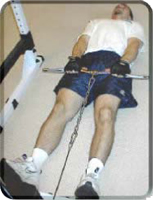
- Lie flat on your back in front of a low pulley (the seated row pulley works well, as it generally will have more weight on it than an ordinary plain pulley setup) with your feet near the pulley.
- Hold the bar or two single-handles with the cable running down between your legs. Make sure your feet are braced against something solid.
- If you are using the handles, bend your knees.
- If you are using the bar, minimize knee bend so that the bar doesnt ride up your legs as you lower the weight.
- Shrug in this position.
- This variation hits higher on your neck and causes no back stress compared to many other shrug variations.
How to incorporate this exercise into your workouts:
This exercise can be done anywhere in your exercise routine.
Common Errors
1. Getting into position improperly
The easiest way to get into position is to have a long length of chain connecting to the handle. Set it for just below the bottom point of the exercise so all you have to do is bend your knees a little to reach the bar.
If you dont have the chain and wish to use all or most of the weight stack, youre going to have to start in a sitting position with your knees bent. Grasp the bar solidly. Now lie back onto the floor keeping your lower back tight and arched and your abs solid. This is also the position you should have on the way back up after completing your set.
Tricks
1. Explode
As with most shrug exercises, your traps will benefit from an explosive movement. This one is no exception. Strive to raise your shoulders right up to your ears as you power your way up from the bottom.
Pulldown Shrugs
Why Is This Exercise So Effective?
The Pulldown Shrug targets the lower portion of the Trapezius muscle that is not affected by regular, upward-pulling shrugs. This area of the traps is primarily worked when you use a downward movement of the shoulder girdle.
How To Do It
- This exercise is done using an overhead pulley (the lat pulldown machine is best).
- Grip the bar with your arms outside shoulder-width apart (this gives your scapulae an angle to pull in at rather than just straight down - it also prevents large shoulder muscles from cutting off the circulation in the neck when the shoulder girdle is up).
- Keep your arms stretched straight overhead (or slightly bent but stiff).
- Keep your torso upright and pull down only at the shoulder girdle. Only your shoulder girdle should move in this exercise.
- Try to feel the pulldown in your lower traps, just above your lower back.
- The reverse grip (palms facing you) will give you the best feel in this exercise, though you can do them with any grip and any width of hand spacing.
- You should keep your torso vertical and your back straight. You may also want to lean forward slightly.


